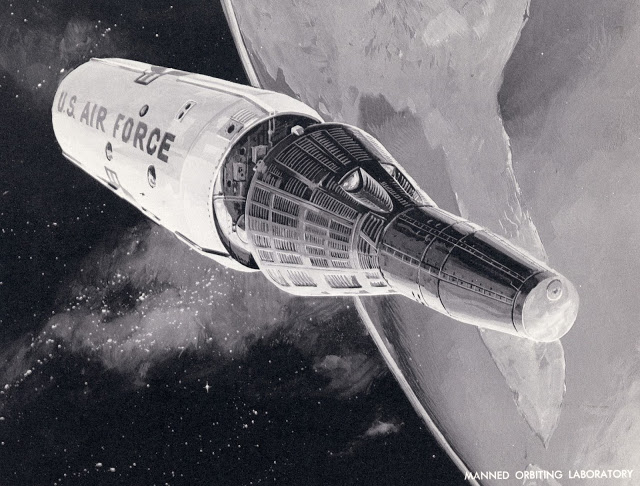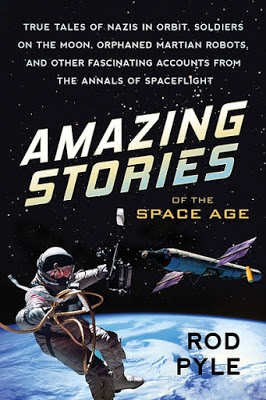 |
| Several proposed military space programs, including the Manned Orbiting Laboratory program, are covered in Amazing Stories of the Space Age, Rod Pyle’s newest book. Image Credit: National Museum of the U.S. Air Force |
“Why didn’t I learn to treat everything like it was the last time. My greatest regret was how much I believed in the future.”
– Jonathan Safran Foer, Extremely Loud and Incredibly Close
Author Rod Pyle’s newest book, Amazing Stories of the Space Age (Prometheus Books), takes a different approach than many other titles in the spaceflight canon. Pyle educates the reader about little-known, little-flown, and defunct programs that didn’t quite make it past the planning stage. Readers discover plans of military space stations, spies in orbit, robots resigned to suffer lonely deaths on remote planets, and a little Soviet space shuttle called…Buran something.
This Space Available interviewed Pyle this week about his newest book. We discussed the impetus behind telling the tales of obscure space programs, and the importance of keeping the stories accurate, despite hard truths. Note: some book spoilers included.
This Space Available: Your newest book, Amazing Stories of the Space Age, often discusses little-known space programs that either flew very briefly (such as Buran, the Soviet space shuttle, which flew only once) or never quite made it off the drawing board (such as plans to have humans orbit Venus, to give one example). What was your motivation to discuss programs that faced, in some cases, certain extinction? What can these defunct programs teach us now?
Rod Pyle: This book began life as a show proposal for The History Channel, where I was working in the mid-2000s. I thought it would be fascinating to look at some of the lesser-known incidents in spaceflight history, especially the space race and shuttle era. We got close to getting it produced, but did not quite make the cut—at the time, the visual effects that would be required were prohibitively expensive. In 2014 I recast the show proposal as a book, but shifted it towards unflown missions from a period roughly 1939 to the 1980s, with some flown missions from that period into the 1990s.
As a space writer, over the years you come across oddball proposals for military lunar bases, spacecraft powered by atomicbombs, lunar weapons, and other weird plans. Most of the material written tends to be either short articles or more scholarly works. I wanted to take a middle path and write a popular book, aimed at the interested lay audience, that would look at some of the lesser-known plans for spaceflight. And besides, how much more fun can you have than talking about the early space age?
TSA: One thing I, as a space writer, appreciated about the book was your willingness to discuss uncomfortable (yet accurate) history, such as von Braun’s past in the SS. You also discussed the many failures in spaceflight on both the U.S. and Soviet sides, acknowledging that both nations faced huge setbacks. Were you nervous about discussing these subjects? I find that sometimes other writers do not broach these topics fully.
Pyle: That’s an interesting question. The good thing about authoring books, as opposed to working in documentary television or journalism, is that you have more time to ponder where you want to take a story. There are, as you point out, some “edgy” topics in such a book, and each one had to be edited on its own merits. Take as an example von Braun: I have always looked at him as one of the Titans of the space age—a brilliant engineer, a vastly capable leader, and a man charismatic enough to charm money out of Congress. Yet he was also somewhat amoral, as indicated by his WWII activities.
Recent and well-documented books about von Braun, such as Michael Neufeld’s Von Braun: Dreamer of Space, Engineer of War have some pretty damning material, gathered from multiple witnesses, about von Braun’s complicity (or at least passive acceptance) of slave labor on the V-2 project when headquartered in the Harz mountains. And of course, he was famously not only a member of the Nazi party, but also of the SS. He claimed that the latter was done under duress, but some historians suggest that it was simply his ruthless drive to succeed in rocketry that caused him to join willingly. In any case, once we weigh the evidence, it’s the author’s job to decide how relevant it is to the story at hand, and to also responsibly portray the subject.
Another difficult choice concerned the death of Vladimir Komarov in the crash of Soyuz 1. There are conflicting descriptions of what happened before the flight, which must be accounted for. There is also the question of how much you show with visuals—do you publish the famous photo of his alleged charred remains being looked over by three grim-faced Soviet military men? Do you owe it to the reader to show all and let the decision to dwell on the grisly reality be their own? Or do you decide that such an image is not only in questionable taste, but unnecessary? In the end, I decided that it was not critical to the story (which is pretty graphic already) and pulled the image out. In the end, I was never particularly nervous about these choices, just contemplative.
 |
| Rod Pyle’s Amazing Stories of the Space Age. Image Credit: Prometheus Books |
TSA: The book has kind of a Cold War spy thriller feel in some parts; I won’t try to spoil too much of the book for prospective readers, but you discuss (thank God, never undertaken) plans to heavily militarize the Moon and low Earth orbit. Do you think that time still has resonances, even though the Cold War is over (at the time of writing this)? In what ways?
Pyle: Well, of course the militarization of space never went away, it just got quieter, less controversial, and robotically
A fine example is the Air Force’s Manned Orbiting Laboratory (MOL), a small space station that would be launched atop a modified Titan III with a Gemini capsule at the top. Two crew members would spend a month in orbit, using a very large optical telescope to spy on the Soviet Union and other countries at impressively high resolutions. Then the crew would return home, the MOL would deorbit and another would be sent aloft—an expensive way to pursue spy-craft. By the time MOL was nearing a point where it could begin serious development, about 1966, robotic satellites were coming online that could do the same work, but did not need life support and cost less (though the savings were not always as one might expect). Today, we have incredibly advanced and hardened electronics that can survive nuclear EMPs and long-duration spaceflight, with increasing amounts of AI and reduced human management. The Air Force’s X-37B mini shuttle is a prime example, now nearing two years in orbit in its fourth mission. But with Russia contemplating military options in space, and China’s capability rising quickly, this is an area to watch carefully.
TSA: The book also addresses little-known missions that did fly, such as the time the Soviets sent organisms (including tortoises!) into trans-lunar space prior to Apollo 8. While these stories add to the fun tone of the book, there are things to be learned from them (in this case, there was a Soviet threat to go to the Moon first). What was your favorite “off the beaten path” spaceflight story like this? (It doesn’t even necessarily have to be in this book.)
Pyle: One simply must love the tale of Buran—poor, tragic Buran. It’s like a space opera as penned by Verdi. Here comes this bridesmaid Soviet shuttle, heavily derived from the US space shuttle designs (which preceded it by a few years), and yet cheaper and better by some measures. It is lofted into space by a very powerful and advanced launch system, Energia, and can fly its entire mission profile robotically—something that the Soviets had pioneered early on, but with far less robustness than the US (at least until their automated docking technology became routinely reliable). So this wonderful system flies once in 1988, just a single mission, fully robotic, and then is parked, never to fly again. And in the final act (where the operatic tragedy usually occurs), 14 years later, it is crushed when a poorly-maintained hangar collapses. There will be no Phoenix-like rise for this bird; the reliability, simplicity and lower cost of the Soyuz doomed Buran before it flew. So that’s a sad, fascinating tale, with an almost anthropomorphic machine—you can really feel for it.
TSA: I think the triumph of this book is how you made it informative, yet readable – those who do not have a previous interest in spaceflight would still enjoy it. The space historian Jay Gallentine is also known for “readable history.” What do you hope to accomplish overall with Amazing Stories of the Space Age? Will we see a sequel?
Pyle: If it’s a triumph, I’m thrilled! Thanks for that suggestion. I love Jay’s work, and who doesn’t want to write like Andy Chaikin? Beyond space history, there are a number of authors who write wonderfully accessible books in other areas of history and nonfiction, and I think space writers do well to heed the lessons from the best of those books: keep it clean, keep it moving, and try not to get to bogged down in the minutia—there are plenty of other folks writing fine reference books, which speak to a different audience (that said, I am careful to site copious references).
It can be a challenge, because it’s easy to get fascinated by some bit of trivia and then dive too deep for the general reader—that’s where good editors earn their pay. My hope for Amazing Stories of the Space Age is that it will appeal to people with an existing appreciation of space history, but perhaps only a nodding awareness of some of the more obscure missions; and that it might be sufficiently engaging to attract general readers into the space-enthusiast fold, because we need all the help and support we can get. The next decade is going to be a challenging one for NASA and other civil space agencies, and public support, as always, is vital to success.
Regarding a sequel: I had so much material left over when the manuscript was submitted that I’m probably close to halfway there already! If this book does well, I’ll be pitching the publisher to start on a follow-on volume before you can say A-Okay, roger and WILCO, over and out.
Emily Carney is a writer, space enthusiast, and creator of the This Space Available space blog, published since 2010. In January 2019, Emily’s This Space Available blog was incorporated into the National Space Society’s blog. The content of Emily’s blog can be accessed via the This Space Available blog category.
Note: The views expressed in This Space Available are those of the author and should not be considered as representing the positions or views of the National Space Society.


















